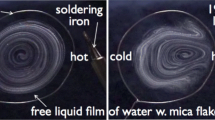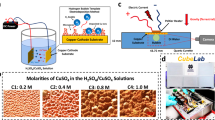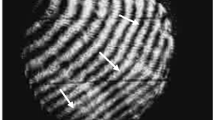Abstract
In this paper, we analyzed the heat and mass transfer at a free surface under microgravity conditions. The SOURCE-II (Sounding Rocket COMPERE Experiment) experiment was performed on a suborbital flight in February 2012 from Esrange in North Sweden. It provided representative data with respect to solid, liquid, and vapor temperatures as well as the visible surface position. The objectives were to quantify the deformation of the free liquid surface and to correlate the apparent contact angle to a characteristic temperature difference between subcooled liquid and superheated wall. Furthermore, the influence of evaporation and condensation at the liquid/vapor interface and at the superheated wall must be taken into account to analyze heat and mass fluxes due to a characteristic temperature difference. In the following, we show evidently that the magnitude of the apparent contact angle depends on the exerted specific pressurizations of the vapor phase during the experiment and hence on the change in the saturation temperature at the free surface. The characteristic temperature difference is defined with respect to the wall temperature in the vicinity of the contact line and the saturation temperature. Therefore, apparent contact angle and temperature difference can be correlated and indicate a specific characteristic. Concerning the heat and mass transfer at the free liquid surface and the contact line, two different methods are presented to evaluate the net mass due to phase change within a certain time interval. In the first approach, the mass flow rate is calculated by means of the ideal gas law and its derivatives with respect to temperature and pressure. The second approach calculates the heat flux as well as the mass flux at the wall and in the region of the free liquid surface. In these cases, a specific heat transfer coefficient and a thermal boundary layer thickness are used.










Similar content being viewed by others
Abbreviations
- SOURCE:
-
Sounding Rocket Compere Experiment
- COMPERE:
-
Comportement des Ergols dans les Reservoir
- A :
-
Area (m2)
- C :
-
Constant
- c p :
-
Specific heat capacity (J/kg K)
- d :
-
Diameter (m)
- H :
-
Height (m)
- h :
-
Height (m)
- Δhv :
-
Latent heat of vapor (J/kg)
- M :
-
Mass flow rate (kg/s)
- M w :
-
Molecular weight (kg/mol)
- m :
-
Mass (kg)
- \(\dot{m}\) :
-
Mass flux (kg/m2 s)
- Δm :
-
Net mass (kg)
- p :
-
Pressure (Pa)
- Q :
-
Volume flow rate (m3/s)
- q :
-
Heat flux (W/m2)
- R :
-
Tank radius (m)
- R i :
-
Individual gas constant (J/kg K)
- r :
-
Radial coordinate (m)
- T :
-
Temperature (°C)
- t :
-
Time (s)
- U :
-
Internal energy (J)
- u :
-
Velocity (m/s)
- V :
-
Volume (m3)
- V′:
-
Liquid volume (m3)
- V″:
-
Vapor volume (m3)
- z :
-
Vertical coordinate (m)
- α :
-
Heat transfer coefficient (W/m2 K)
- γ :
-
Apparent contact angle (°)
- γ s :
-
Static contact angle (°)
- δ :
-
Distance (m)
- Θ :
-
Characteristic temperature difference (K)
- κ :
-
Thermal diffusivity (m2/s)
- k :
-
Isentropic coefficient
- λ :
-
Thermal conductivity (W/m K)
- ν :
-
Kinematic viscosity (m2/s)
- ρ :
-
Density (kg/m3)
- σ :
-
Surface tension (N/m)
- σ T :
-
Surface tension gradient (N/m K)
- φ :
-
Azimuthal coordinate (°)
- G:
-
Vapor (gas)
- i :
-
Index number
- L:
-
Liquid
- m:
-
Mean
- n :
-
Final number
- S:
-
Solid
- s :
-
Saturation
- W:
-
Wall
References
Ajaev VS (2005) Spreading of thin volatile liquid droplets on uniformly heated surfaces. J Fluid Mech 528:279–296
Ajaev VS, Gambaryan-Roisman T, Stephan P (2009) Static and dynamic contact angles of evaporating liquids on heated surfaces. J Colloid Interface Sci 342:550–558
Anderson DM, Davis SH (1995) The spreading of volatile liquid droplets on heated surfaces. Phys Fluids 7(2):248–265
Baehr HD, Stephan K (1994) Wärme- und Stoffübertragung. Springer, Berlin
Das SP, Hopfinger EJ (2009) Mass transfer enhancement by gravity waves at a liquid-vapour interface. Int J Heat Mass Transf 52:1400–1411
Fuhrmann E, Dreyer ME (2008a) Wall heat transfer induced by surface tension driven flow—a numerical Prediction for a sounding rocket flight experiment SOURCE. Proceedings of third international symposium on physical science in space 2008. J Jpn Soc Microgravity Appl 25(3):37–41
Fuhrmann E, Dreyer ME (2008b) Description of the sounding rocket experiment SOURCE. Microgravity Sci Technol 20(3/4):205–212
Fuhrmann E, Dreyer ME (2009) Heat transfer by thermocapillary convection, sounding rocket COMPERE experiment SOURCE. Microgravity Sci Technol 21(Suppl 1):87–93
Herbert S (2012) Numerical simulation of evaporation processes at single menisci. Master Thesis by Stefan Herbert, Technical University Darmstadt, Germany
Ibrahem K, Abd Rabbo MF, Gambaryan-Roisman T, Stephan P (2010) Experimental investigation of evaporative heat transfer characteristics at the 3-phase contact line. Exp Thermal Fluid Sci 34:1036–1041
Krahl R, Adamov M, Lozano Avilés M, Bänsch E (2004) A model for two phase flow with evaporation. Two-Phase Flow Modelling and Experimentation 4:2381–2387
Kulev N, Dreyer ME (2010) Drop tower experiments on non-isothermal reorientation of cryogenic liquids. Microgravity Sci Technol 22:463–474
Kunkelmann C, Stephan P (2010) Numerical simulation of the transient heat transfer during nucleate boiling of refrigerant HFE-7000. Int J Refrig 33:1221–1228
Raj R, Kunkelmann C, Stephan P, Plawsky J, Kim J (2012) Contact line behavior for a highly wetting fluid under superheated conditions. Int J Heat Mass Transf 55:2664–2675
Sodtke C, Ajaev VS, Stephan P (2007) Evaporation of thin liquid droplets on heated surfaces. Heat Mass Transfer 43:649–657
Sodtke C, Ajaev VS, Stephan P (2008) Dynamics of volatile liquid droplets on heated surfaces: theory versus experiment. J Fluid Mech 610:343–362
Stephan P (1992) Wärmedurchgang bei Verdampfung aus Kapillarrillen in Wärmerohren. Fortschrittberichte VDI Reihe 19:Wärmetechnik/Kältetechnik 59
Stephan P, Hammer J (1994) A new model for nucleate boiling heat transfer. Heat Mass Transfer 30:119–125
Stephan K, Mayinger F (1992) Thermodynamik Band 1: Einstoffsysteme—Grundlagen und Technische Anwendungen. Springer, Berlin
Wayner PC Jr (1993) Spreading of a liquid film with a finite contact angle by the evaporation/condensation process. Langmuir 9:294–299
Acknowledgments
This project is funded by the space agency of the German Aerospace Center with resources of the Federal Ministry of Economics and Technology on the basis of a resolution of the German Bundestag under Grant Number 50 RL 0921. The principle investigators of the SOURCE experiment gratefully acknowledge the support by the European Space Agency (ESA) through the microgravity application program (MAP) Project AO-2004-111. The open and stimulating discussion within the COMPERE group during the preparation and evaluation of this experiment was always very helpful. We thank SSC and their subcontractors for the design, the manufacturing, and the successful flight of the SOURCE-II module. In the frame of private communication, we gratefully acknowledge the work of Stefan Herbert who computed the contact angle by means of the microregion model.
Author information
Authors and Affiliations
Corresponding author
Rights and permissions
About this article
Cite this article
Fuhrmann, E., Dreyer, M.E. Heat and mass transfer at a free surface with diabatic boundaries in a single-species system under microgravity conditions. Exp Fluids 55, 1760 (2014). https://doi.org/10.1007/s00348-014-1760-2
Received:
Revised:
Accepted:
Published:
DOI: https://doi.org/10.1007/s00348-014-1760-2




